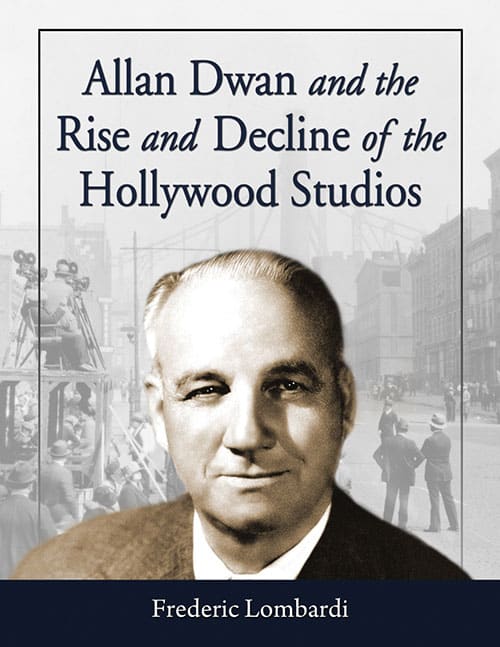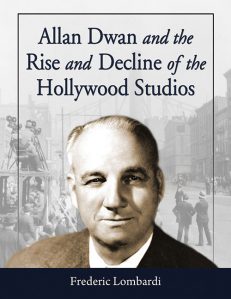Allan Dwan and the Rise and Decline of the Hollywood Studios
$39.95
In stock
About the Book
It could be said that the career of Canadian-born film director Allan Dwan (1885–1981) began at the dawn of the American motion picture industry. Originally a scriptwriter, Dwan became a director purely by accident. Even so, his creativity and problem-solving skills propelled him to the top of his profession. He achieved success with numerous silent film performers, most spectacularly with Douglas Fairbanks Sr. and Gloria Swanson, and later with such legendary stars as Shirley Temple and John Wayne. Though his star waned in the sound era, Dwan managed to survive through pluck and ingenuity. Considering himself better off without the fame he enjoyed during the silent era, he went on to do some of his best work for second-echelon studios (notably Republic Pictures’ Sands of Iwo Jima) and such independent producers as Edward Small. Along the way, Dwan also found personal happiness in an unconventional manner. Rich in detail with two columns of text in each of its nearly 400 pages, and with more than 150 photographs, this book presents a thorough examination of Allan Dwan and separates myth from truth in his life and films.
About the Author(s)
Bibliographic Details
Frederic Lombardi
Format: softcover (8.5 x 11)
Pages: 384
Bibliographic Info: 158 photos, filmography, notes, bibliography, index
Copyright Date: 2013
pISBN: 978-0-7864-3485-5
eISBN: 978-0-7864-9040-0
Imprint: McFarland
Table of Contents
Acknowledgments ix
Preface 1
Part One: The Lusty Child 3
1. Prelude 4
2. Pioneering 12
3. The Age of Fairbanks 52
4. The Pursuit of Independence 96
5. Swanson and Swan Song 121
Part Two: Keep Your Head Down! 169
6. Fox and Trot 170
7. Escape Into Comedy 222
8. The Sands of Republic 249
9. Apotheosis with Bogeaus 278
10. The Final Act 306
Filmography 331
Chapter Notes 345
Selected Bibliography 360
Index 363
Book Reviews & Awards
- “No one will ever match the author for exhaustiveness as he explores Dwan’s long career…every film is examined in depth, with contemporary press coverage and reviews filling in the gaps where the movies no longer survive. Dwan has never had a more diligent champion than Lombardi.”—Leonard Maltin.com
- “Excellent biography of the man and his films…impeccably researched, cleanly written and a huge overall boon to film scholarship”—Scott Eyman, The Palm Beach Post
- “One of the best film books of 2013…thoroughly researched…does much to advance the director as one of the greats”—Thomas Gladysz, the Huffington Post
- “Exhaustively researched”—Dave Kehr, The New York Times
- “A fascinating look at the studio system from its Wild West days at the beginning through Hollywood’s golden age and postwar era…. The book is a masterful achievement in cinematic archaeology. While the most appealing aspect of Allan Dwan and the Rise and Decline of the Hollywood Studios is the rich history of Dwan and his work at the studios, Lombardi also brings in critical commentary throughout, by others as well as himself. This makes the book doubly useful as both history and analysis, and in the case of the former aspect, surely definitive. This is essential reading for anyone who wants to understand not just the life and career of a specific director but the story of the American studio system from its hardscrabble beginnings through the golden age and beyond”—Gary Morris, Bright Lights Film Journal
- “We should be grateful to Fred Lombardi. This is a thoroughly researched book which no film aficionado can afford to be without”—Kevin Brownlow, 2010 Honorary Academy Award winner
- “Totally remarkable book on Allan Dwan…so wonderfully dense with information, insights, judicious speculation, etc, etc…in short it is an instant classic, one of the three or four finest books on film that I have ever read.”—Kevin Thomas, retired film critic, Los Angeles Times
- “Lombardi’s fluidly written work far exceeds in detail and research any preexisting study of Dwan”—Cineaste
- “Lombardi has done his homework. His Allan Dwan is a revelation, a testament to the fruits of untiring and solid research. Every page reveals the always reliable Dwan as a prolific and versatile filmmaker, whose work touched upon every genre and aspect of the evolving studio system in Hollywood’s Golden Age. He was the architect behind Douglas Fairbanks’s best pictures, from the early comedies to the swashbuckling costume epic, Robin Hood. Gloria Swanson, John Wayne, and Shirley Temple, among so many others, all benefited from his sure touch. We can only wonder why it has taken so long to restore this master director to his rightful place in the Hollywood firmament. We are profoundly grateful to Mr. Lombardi.”—John C. Tibbetts, author of Douglas Fairbanks and the American Century






